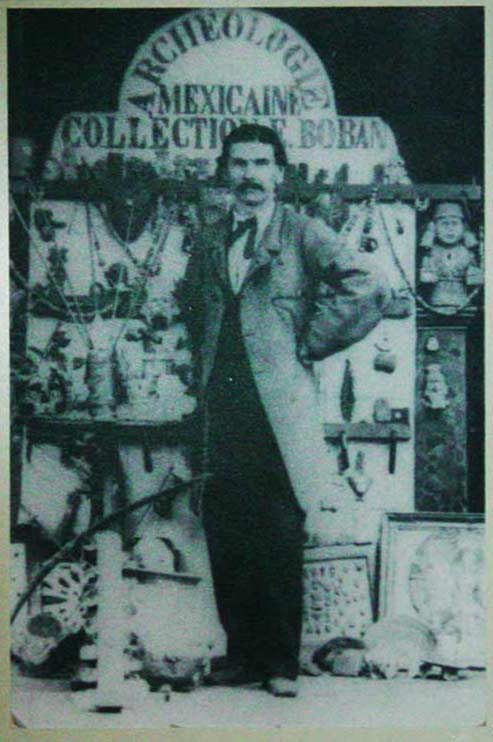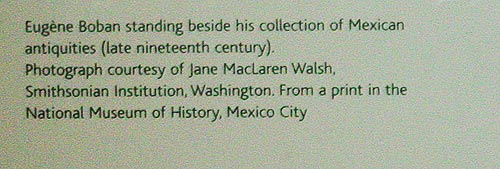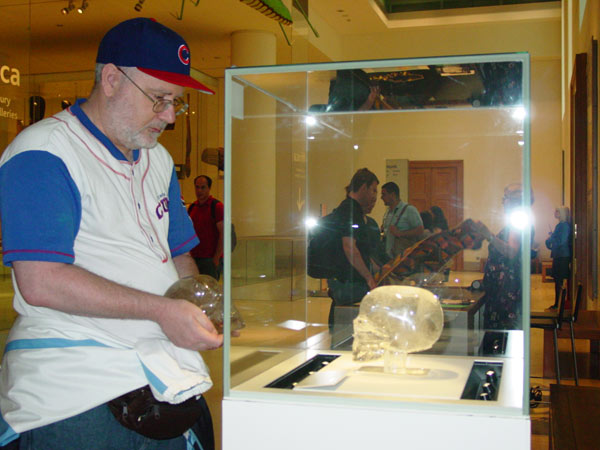The British Museum Crystal Skull
The Crystal Skull
Department of Ethnography
Ethno 1898-1
Large quartz crystal skulls have generated great interest and fascination since they began to surface in public and private collections during the second half of the nineteenth century. This particular example in the collections of the Ethnography Department was acquired by the British Museum in 1897 and ever since has been the subject of much speculative interpretation.
What is it made of?
In the 1960s and again in the1990s scientists in the Department of Scientific Research at the British Museum, aided by Professor A. Rankin,of Kingston University, examined the skull to determine its origin and the techniques used in its manufacture. The material used is quartz crystal and careful study of the inclusions suggests that it is most likely to have originally come from quartz crystal deposits in Brazil.
How was it made?
The surface of the skull, examined under the microscope, presents a high polish and shows traces of fine regular grooves. These features indicate that it was shaped using a rotary drill and wheel in conjunction with a diamond abrasive.
How was it acquired?
According to the Museum records the crystal skull was acquired in 1897 from Tiffany and Co. of New York, through Mr G. F. Kunz. In an earlier publication Mr Kunz states that it was brought from Mexico by a Spanish officer before the French occupation. Sold to an English collector, it was acquired at his death by Eugène Boban, a French antiquity dealer, and later became the property of Tiffany and Co, NY. However new archival research by Jane M. Walsh, from the Smithsonian Institution, shows that its provenance is far from clear.
How old is it?
Some of the crystal skulls have been attributed to the work of Aztec, Mixtec or even Maya lapidaries. Others are said to be examples of colonial Mexican art, for use in churches, perhaps as bases for crucifixes.
Stone objects cannot be dated directly by the techniques available today. The skull was compared to a group of rock crystal objects that came from well-documented excavations in Mexico City and Oaxaca (Mexico) and experiments were carried out to study the marks left by modern and ancient tools. The extensive traces of the wheel on the skull and its high polish suggests that it was made in a workshop using traditional European techniques, and therefore after the arrival of Europeans in Mexico and Central America.
Rock crystal has been available from at least two sources in Brazil during the past century, but was unknown during the eighteenth century, save in the form of pebbles or boulders found in rivers. In the early nineteenth century large quantities of Brazilian rock crystal were shipped to Germany. Some evidence suggests that Boban could have acquired the crystal skull there. This would be consistent with the inferred Brazilian origin of the quartz from which the skull was made.
Who made it and for what purpose?
None of the known large skulls have come from a controlled and well documented excavation. During the second half of the nineteenth century interest in collecting ancient artifacts from Mexico was at its height. Large quantities of forgeries were produced at this time to supply the demand in the US and Europe, some of which made their way into museums and private collections. This may have been the case with this particular example.
Further reading:
- Walsh, J. M. Crystal skulls and other problems. In: Exhibiting Dilemmas: Issues of Representation at the Smithsonian. A. Henderson and A.L Kaeppler (eds.) Washington and London: Smithsonian Institution Press, 1997.
- Jones, M. The Limits of Expertise. In : Fake? The Art of Deception. London: BMP, 1990.
- Kunz, G.F. Gems and Precious Stones of North America. New York. pp. 285-6, 1890.
- British Museum Visitor Services
Telephone: +44 (0)20 7323 8299
Facsimile: +44 (0)20 7323 8616
Switchboard: +44 (0)20 7323 8000
Address: Great Russell Street, London WC1B 3DG
Email: information@thebritishmuseum.ac.uk
Website: http://www.thebritishmuseum.ac.uk
Here is a duplication of the signs which are on a wall behind the British Museum Crystal Skull which is displayed within a glass case (see the final photo). This is the latest statements made by the Museum about their crystal skull and as you will read they believe this crystal skull is of recent manufacture of what we would call an "Old Crystal Skull".
In order to duplicate the signs we took photographs of each one and used Adobe Photoshop to make the sign appear as clear as possible. The photographs below for the signs are shown in the order they are presented.
Text:
Rock Crystal Skull
Late 19th century AD
It was originally thought to have
been Aztec, but recent research
proves it to be European.
Purchased from Tiffany and Co., New York
through Mr. G. F. Kunz Ethno 1898-1
(Ethno - is the Ethnology Department,
exhibited first in January of 1898)

The sign displayed behind the glass case with the museum Crystal Skull is quite large so we show it in parts starting from the portion of the sign from the viewers left to right. Here you can see the Museum questions the authenticity of the origins of the crystal skulls and discussed Boban, who had the museum skull in Mexico possibly since the 1860's as he tried to sell it for a long time.
In Summary:
The Museum calls its skull a fake meaning that the tool marks found on the surface are believed to have been done by modern carvers possibly in the 1800's as this skull is first reported to appear in the 1860's. But the museum has never tried to explain any of the stories of strange phenomena which has occurred around this crystal skull or why so many people are fascinated by it. One day perhaps this mystery will be resolved.
Part III and IV of the British Museum Report will come within next week, so stay tuned for our email - this is will including an interview with one of the Museum Experts and what happened to Joshua when he was allowed to touch the skull in 2003.
We hope you enjoyed our special report about the British Museum Crystal Skull,
in peace and light always,
Joshua & Katrina
your Crystal Skull Explorers
email: crystalskullexplorers@gmail.com
telephone: 1-312-473-2790
Photo Credit for the the British Museum pictures on this page, they were taken by Zane Bonara-Bell and Joshua Shapiro during his visit to the British Museum in June of 2009.
















Comments (3)
So what did happen to Joshua when he was allowed to touch the skull in 2003?
Rob – good questions — what happened was two things – one I was able to touch the British Museum Crystal Skull with both hands and I think this was to help energize it more than for me to receive an energy and the second part of this experience was I was touching in my left hand our personal skull known as “Portal de Luz” (see under the menu About Us – the Crystal Kids) and with my right hand through the glass case which the British Museum Crystal Skull was contained with, and it feel as if energy from “Portal” was going into the British Skull to help re-activate – as this skull for the most part, up to this time, was not in the public and certainly the museum wasn’t going to allow anyone to work with the skull – hope this makes sense Rob —
— what happened was two things – one I was able to touch the British Museum Crystal Skull with both hands and I think this was to help energize it more than for me to receive an energy and the second part of this experience was I was touching in my left hand our personal skull known as “Portal de Luz” (see under the menu About Us – the Crystal Kids) and with my right hand through the glass case which the British Museum Crystal Skull was contained with, and it feel as if energy from “Portal” was going into the British Skull to help re-activate – as this skull for the most part, up to this time, was not in the public and certainly the museum wasn’t going to allow anyone to work with the skull – hope this makes sense Rob —  Joshua
Joshua
This idea that high speed rotary cutting tools can only be “modern,” doesn’t hold water for me. Chris Dunn proved beyond a doubt that in ancient Egypt, high speed powered stone cutting tools left marks everywhere in that country. There is even a vase machined out of solid stone on a stone cutting lathe, but the INSIDE of the vase with its skinny neck was also cut by high speed cutting tools, we don’t even know how they did this and can’t duplicate it. Quartz and granite are about the same hardness. If they were doing that kind of work in ancient Egypt it completely blows away the “dating” of the crystal skulls. There have never been found any of the tools that granite was cut to optical precision found in any archaeological digs or remains. Yet archaeologists tell us these people did all this incredible optical precise cuts and polishing with copper chisels!. Dunn even found a Sphinx with bilateral perfect 3D stone cutting marks, and obelisks with identical hieroglyphics cut with small ROTARY high speed cutters in computer-like precision, identical on all sides. These egg heads are “IN the box” thinkers, the debunking of crystal skulls work that was done is totally worthless. I believe that Hewlett Packard found that the jaw on the MH skull was a continuous part of the raw crystal it was cut from, and correctly point out this is impossible to do, you lose so much material that there would be a noticeable gap in the crystal grain and structure if anybody tried to do that today. HP said they couldn’t duplicate it. So many mysterious, and admittedly alot of flaky New Age theories like the skulls being from actual ancient bodies crystallized, etc. or channelings or seeing “images” in the quartz that are hard to swallow, even for a Newager guy like I have been Dorland thought the effects of the MY skull were purely from the purity and BULK of a large piece of quartz with its piezo-electrical qualities. Fascinating subject for sure. I do think that somehow when quartz is carved into a human skull shape it does “something.”
Dorland thought the effects of the MY skull were purely from the purity and BULK of a large piece of quartz with its piezo-electrical qualities. Fascinating subject for sure. I do think that somehow when quartz is carved into a human skull shape it does “something.”